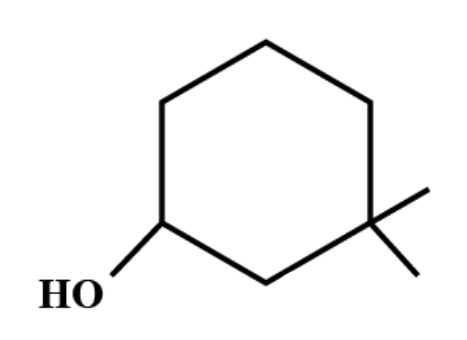
The IUPAC name of the compound is:

(A) $ 3,3-dimethyl-1-cyclohexanol. $
(B) $ 1,1-dimethyl-3-hydroxy\text{ }cyclohexane. $
(C) $ 3,3-dimethyl-1-\text{ }hydroxy\text{ }cyclohexane. $
(D) $ 1,1-dimethyl-3-cyclohexanol. $

Answer
515.1k+ views
Hint: We know that isomers are different in physical and chemical properties but have the same number of atoms. This phenomenon is termed as isomerism. Parent carbon chain can be determined by calculating the number of carbons in the longest carbon chain. Alkanes are the hydrocarbons which have no double or triple bond in their structures.
Complete answer:
If organic compounds contain one principal functional group then the longest continuous chain of carbon atoms having that functional group is selected. Functional groups are specific substituents in the molecules which are responsible for the characteristic chemical reactions of those molecules.
As per IUPAC rules, the first thing is to select the longest continuous chain. Then this chain is numbered and the numbering should begin from the end which is close to the substituent groups. Each substituent group has a certain assigned name whose numbering depends on the position of the carbon it has been attached to. These groups are generally arranged alphabetically.

Therefore, the IUPAC name of the compound is $ 3,3-dimethyl-1-cyclohexanol. $
Constitutional isomers have the same molecular formula but numbering and IUPAC names are different. Only count the number of each atom in both molecules to see how atoms are organized to decide whether two molecules are constitutional isomers.
Note:
Remember that Isomers are classified as structural (constitutional) and stereoisomerism. Structural isomers are further classified as chain isomers, position isomers and functional group isomers. Position isomers are also structural or constitutional isomers with the same functional group and same carbon skeleton but differing in position of the same functional group on or inside the carbon chain.
Complete answer:
If organic compounds contain one principal functional group then the longest continuous chain of carbon atoms having that functional group is selected. Functional groups are specific substituents in the molecules which are responsible for the characteristic chemical reactions of those molecules.
As per IUPAC rules, the first thing is to select the longest continuous chain. Then this chain is numbered and the numbering should begin from the end which is close to the substituent groups. Each substituent group has a certain assigned name whose numbering depends on the position of the carbon it has been attached to. These groups are generally arranged alphabetically.

Therefore, the IUPAC name of the compound is $ 3,3-dimethyl-1-cyclohexanol. $
Constitutional isomers have the same molecular formula but numbering and IUPAC names are different. Only count the number of each atom in both molecules to see how atoms are organized to decide whether two molecules are constitutional isomers.
Note:
Remember that Isomers are classified as structural (constitutional) and stereoisomerism. Structural isomers are further classified as chain isomers, position isomers and functional group isomers. Position isomers are also structural or constitutional isomers with the same functional group and same carbon skeleton but differing in position of the same functional group on or inside the carbon chain.
Recently Updated Pages
Why are manures considered better than fertilizers class 11 biology CBSE

Find the coordinates of the midpoint of the line segment class 11 maths CBSE

Distinguish between static friction limiting friction class 11 physics CBSE

The Chairman of the constituent Assembly was A Jawaharlal class 11 social science CBSE

The first National Commission on Labour NCL submitted class 11 social science CBSE

Number of all subshell of n + l 7 is A 4 B 5 C 6 D class 11 chemistry CBSE

Trending doubts
10 examples of friction in our daily life

One Metric ton is equal to kg A 10000 B 1000 C 100 class 11 physics CBSE

Difference Between Prokaryotic Cells and Eukaryotic Cells

1 Quintal is equal to a 110 kg b 10 kg c 100kg d 1000 class 11 physics CBSE

State the laws of reflection of light

Explain zero factorial class 11 maths CBSE




